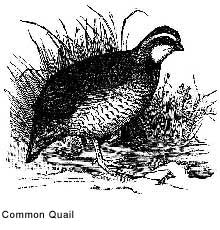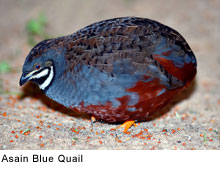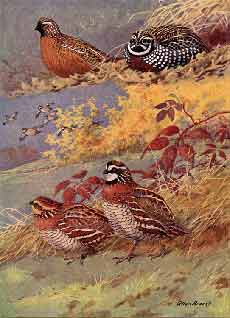
Features: The Common Quail is a small (17 cm) rotund bird, essentially streaked brown with a white eyestripe, and, in the male, a black chin. As befits its migratory nature, it has long wings, unlike most typically short-winged gamebirds.

 The Common Quail, Coturnix coturnix, is from the pheasant family Phasianidae of the order Galliformes, gallinaceous birds. The Common Quail, Coturnix coturnix, is from the pheasant family Phasianidae of the order Galliformes, gallinaceous birds.
To Fly or Walk? This is a terrestrial species, feeding on seeds and insects on the ground. It is notoriously difficult to see, keeping hidden in crops, and reluctant to fly, preferring to creep away instead. Even when flushed, it keeps low and soon drops back into cover. Often the only indication of its presence is the distinctive "wet-my-lips" repetitive song of the male.

Common Quail: Upon attaining an age of 6-8 weeks, this quail breeds on open arable farmland and grassland across most of Europe and Asia, laying 6-18 eggs in a ground nest. The eggs take from 16-18 days to hatch.
 The Asian Blue Quail: This quail has become very popular to keep and The Asian Blue Quail: This quail has become very popular to keep and
breed and numerous mutations of have been developed. They are quite hardy
once they have adjusted to their surroundings and keep the bottom of
an aviary spotless.
They are hyperactive breeders and reproduce at an incredible rate.
The females will lay an egg a day if
kept on the proper diet. The cost
of purchasing and maintaining them is very little, they will make a soft "crowing" type noise to attract a mate, they take up only a small amount of time to feed and water them, they need only about a two foot long cage to breed succsesfully, and their eggs are easily collected and incubated. They are charming to observe, and in some cases have been known to become hand-tamed.

 Trivia: Some cuckoo clocks do not only have a cuckoo indicating the hours, Trivia: Some cuckoo clocks do not only have a cuckoo indicating the hours,
but also a quail indicating the quarters of the hour.
Eggs of the Common Quail were flown onboard the Cosmos 1129 biosatellite.
Quail Cuisine: The quail family of birds includes edible game species. The Common Quail was previously much favoured in French cooking, but quail for the table are now more likely to be domesticated Japanese Quail.
Quail are commonly eaten complete with the bones, since these are easily chewed and the small size of the bird makes it inconvenient to remove them. The eggs of quail are considered a delicacy, and are sometimes used raw in sushi.
Genus Coturnix
o Coturnix coturnix, Common Quail
o Coturnix japonica, Japanese Quail
o Coturnix pectoralis, Stubble Quail
o Coturnix novaezelandiae, New Zealand Quail Extinct
o Coturnix coromandelica, Rain Quail
o Coturnix delegorguei, Harlequin Quail
o Coturnix ypsilophora, Brown Quail
o Coturnix adansonii, Blue Quail
o Coturnix chinensis, Blue-breasted Quail
Genus Anurophasis
o Anurophasis monorthonyx, Snow Mountain Quail
Genus Perdicula
o Perdicula asiatica, Jungle Bush-quail
o Perdicula argoondah, Rock Bush-quail
o Perdicula erythrorhyncha, Painted Bush-quail
o Perdicula manipurensis, Manipur Bush-quail
Genus Ophrysia
o Ophrysia superciliosa, Himalayan Quail Critically Endangered/Extinct
All text is available under the terms
of the GNU Free Documentation License
|